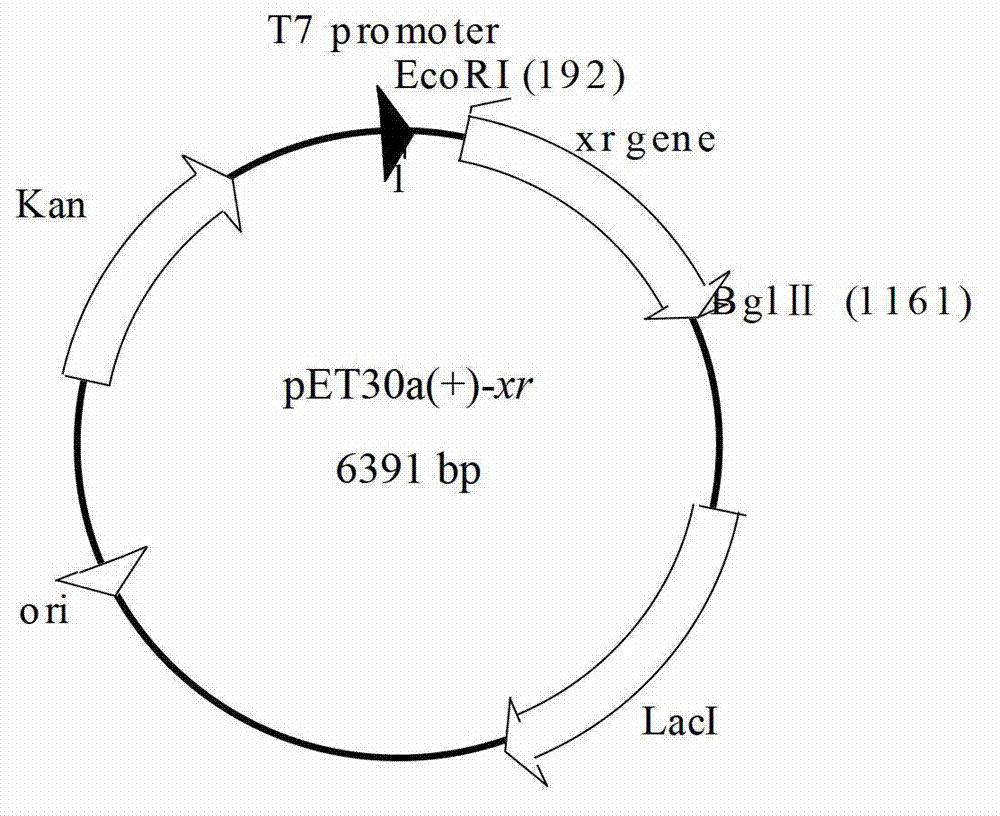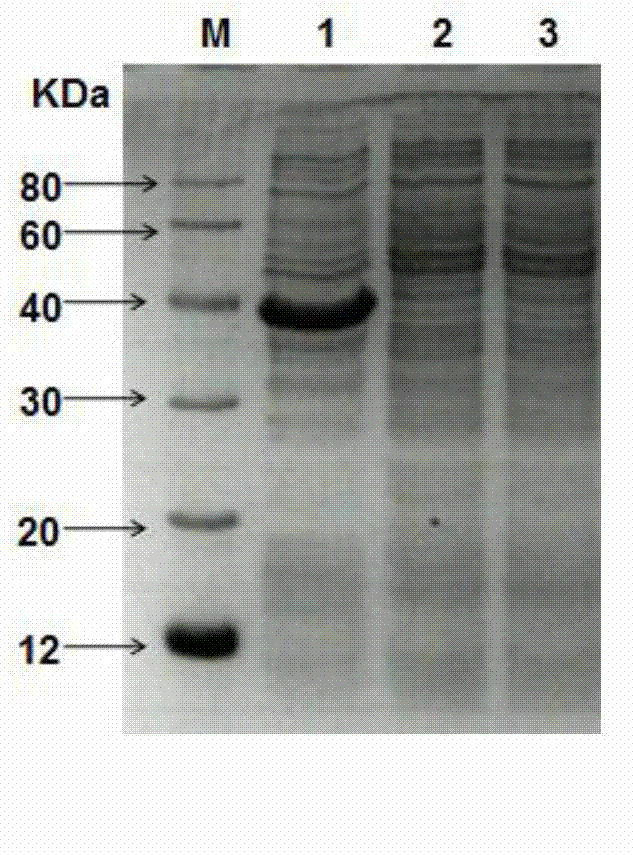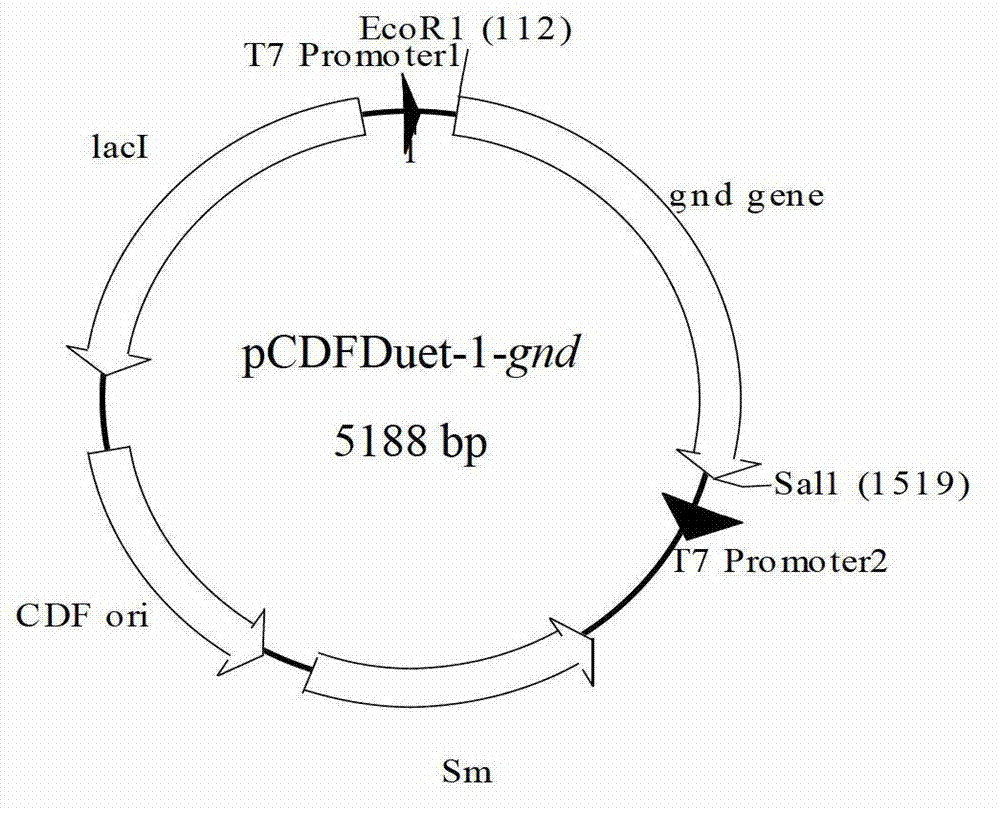Gene engineering strain and application thereof
A genetically engineered bacteria and gene technology, applied in the fields of genetic engineering and biology, can solve the problems of little yield, difficult separation and purification of arabitol, poor specificity of xylose reductase, etc., and achieve the effect of improving enzyme activity
- Summary
- Abstract
- Description
- Claims
- Application Information
AI Technical Summary
Problems solved by technology
Method used
Image
Examples
Embodiment 1
[0058] Example 1 Construction of genetically engineered bacteria E.coli BL21 (pET30a-xr)
[0059] 1 Obtaining the xylose reductase gene
[0060] (1) According to the xylose reductase gene (xr) sequence (Gene ID: 2593996254, SEQ ID No.1) published on NCBI and the characteristics of the multiple cloning site on the expression vector pET30a(+), design using bioinformatics software Synthesize degenerate primers, the upstream and downstream primers are:
[0061] P1: 5'-GA AGATCT GATGGTACCAGGTCTAAGGCTCAACTC-3' (the underline is the BglⅡ restriction site) (SEQ ID No.4);
[0062] P2: 5'-CG GAATTC CTATGCGAAAAACCAGAGGTTCTC-3'; (contains EcoR Ⅰ restriction site) (SEQ ID No.5);
[0063] (2) Culture Neurospora crassa and extract its total DNA;
[0064] (3) Using the total DNA as a template and using P1 and P2 as primers, carry out PCR amplification;
[0065] The PCR reaction system is: 25 μL DNA PrimerStarMix, 21 μL H 2 O, 1.5 μL P1, 1.5 μL P2, 1 μL DNA template.
[0066] The PCR ...
Embodiment 2
[0084] Example 2 Construction of genetically engineered bacteria E.coli BL21 (pET30a-xr+pCDFDuet-1-gnd) 1 to obtain gnd gene
[0085] (1) According to the 6-phosphogluconate dehydrogenase gene (gnd) sequence (GeneID: 388478084, SEQ ID No.2) published on NCBI and the characteristics of the multiple cloning site on the expression vector pCDFDuet-1, using bioinformatics software Design and synthesize degenerate primers, the upstream and downstream primers are:
[0086] P3: 5'-TCC GAATTC GATGTCAAAGCAACAGATCGG-3' (containing EcoR Ⅰ restriction site) (SEQ ID No.6);
[0087] P4: 5'-GCTT GTC GAC TTAATCCAGCCATTCGGTATG-3' (containing Sal Ⅰ restriction site) (SEQ ID No.7).
[0088] (2) Using E.coli K-12 genomic DNA as a template, PCR amplification was performed using primers P3 and P4;
[0089]The PCR reaction system is: 25 μL DNA PrimerStarMix, 21 μL H 2 O, 1.5 μL P3, 1.5 μL P4, 1 μL DNA template.
[0090] The PCR reaction conditions were: pre-denaturation at 95°C for 2 min; den...
Embodiment 3
[0108] Example 3 Construction of engineering bacteria E.coli BL21 (pET30a-xr+pCDFDuet-1-gnd-zwf)
[0109] 1 Get the zwf gene
[0110] (1) According to the glucose 6-phosphate dehydrogenase gene (zwf) sequence (GeneID: 388477926, SEQ ID No.3) published on NCBI and the characteristics of the multiple cloning site on the expression vector pCDFDuet-1, the bioinformatics software was used to design Synthesize degenerate primers, the upstream and downstream primers are:
[0111] P5: 5'-TGGC AGATCT CATGGCGGTAACGCAAACA-3' (containing Bgl Ⅱ restriction site) (SEQ ID No.8);
[0112] P6: 5'-CAGA CTCGAG TTACTCAAACTCATTCCAGG-3' (containing Xho Ⅰ restriction site) (SEQ ID No.9);
[0113] (2) Using E.coli K-12 genomic DNA as a template, PCR amplification was performed using primers P5 and P6;
[0114] The PCR reaction system is: 25 μL DNA Primer StarMix, 21 μL H 2 O, 1.5 μL P5, 1.5 μL P6, 1 μL DNA template.
[0115] The PCR reaction conditions were: pre-denaturation at 95°C for 2 min...
PUM
 Login to View More
Login to View More Abstract
Description
Claims
Application Information
 Login to View More
Login to View More - R&D
- Intellectual Property
- Life Sciences
- Materials
- Tech Scout
- Unparalleled Data Quality
- Higher Quality Content
- 60% Fewer Hallucinations
Browse by: Latest US Patents, China's latest patents, Technical Efficacy Thesaurus, Application Domain, Technology Topic, Popular Technical Reports.
© 2025 PatSnap. All rights reserved.Legal|Privacy policy|Modern Slavery Act Transparency Statement|Sitemap|About US| Contact US: help@patsnap.com



